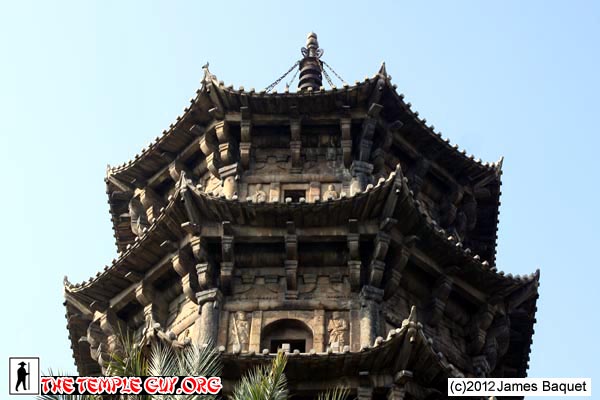(1) Kaiyuan Temple is justly famous for its two pagodas. This is the westernmost (the first thing I saw, as my taxi driver wisely dropped me at the West Gate, avoiding the madhouse on the narrow street in front of the Main Gate). This is the "Renshou" Pagoda, of which I took way too many pictures.
(2) Renshou Pagoda (detail), one of the eaves
(3) Renshou Pagoda (detail), with a small Bodhi tree in front
(4) Renshou Pagoda (detail), surrounded by trees
(5) Renshou Pagoda (detail), the top
(6) Renshou Pagoda (detail), one of the many pairs of figures flanking the windows and doors
(7) Renshou Pagoda
(8) Renshou Pagoda (detail), the base. People typically circumambulate clockwise, with the pagoda (and thus the Buddha) at the right shoulder.
(9) A Qilin on a screen wall near the Renshou Pagoda
(10) A bixi (turtle with stele on its back, though this one's stele had broken off). His face caught my fancy; cartoonish.
(11) A Song-dynasty pagoda in the main courtyard; one of two.
(12) Song-dynasty pagoda (detail)
(13) A pity that they would mark these Song-dynasty pagodas as special, then jam an incense kiosk up against one. Really detracts from the effect!
(14) There were several other small pagodas in the main courtyard; this one has a tree resting on it (though a prop has been added, off-camera to the right, to ease its burden).
(15) Long view across the front of the main hall
(16) Inside the main hall are the Buddhas of the Five Directions.
(17) "Five Directions," you ask? Yes: this one at the center is "Center," the others being the usual four compass points.
(18) This mulberry tree is said to be over a thousand years old; it's next to the main hall.
(19) Behind the main hall, this pretty little hall is overhung by two ancient Bodhi trees. Inside is the "Sweet Dew Discipline Altar." (I'm dying to know what that means!)
(20) Roots of one of the ancient Bodhi trees. I actually sat serenely on these roots for a few minutes; passersby gawked.
(21) The "Sweet Dew Discipline Altar." A knowledgeable and kind monk did some interpreting: That's Vairocana Buddha at the top (see next pic); he's surrounded by Four Great Bodhisattvas (NOT Guanyin, but Puxian, Wenshu, Dizang, and Dashizhi, to use their Chinese names); in front of Vairocana, with the "halo," is Shakyamuni, the historic Buddha, and in front, is the Amitabha Buddha (Amitofo) charmingly flanked by the two great friends Hanshan and Shide. I sure want to know how they got in there! Also, in the right foreground, you can see one of the eight (two on a side, flanking four stairways) guardians called tianzun.
(22) Vairocana on the "Sweet Dew Discipline Altar." As the monk who explained things to me was standing in front, he neglected to tell me anything about the figures behind Vairocana. Something else to research!
(23) A bit of folk art on an old building on the temple grounds, near the Buddhist Museum (closed when I was there.)
(24) The easterly pagoda at the temple, called the Zhenguo Pagoda. I geeked out on this one, too, but I'll spare you the repetition.
(25) Zhenguo Pagoda (detail). That's all for this temple!
| ← Previous Site | Back to Trip 14 Introduction | Next Site → |
Last Updated August 11, 2019


























No comments:
Post a Comment